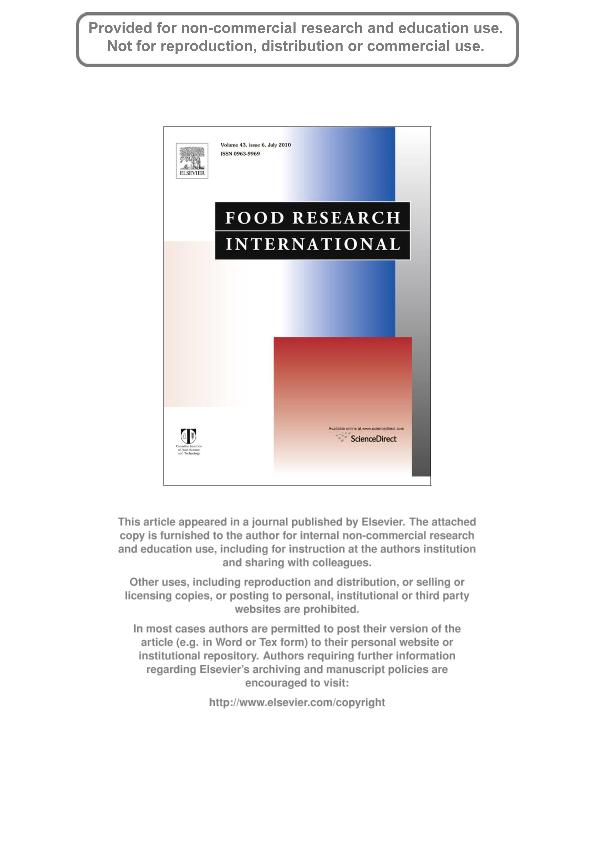Mostrar el registro sencillo del ítem
dc.contributor.author
Schinella, Guillermo Raúl

dc.contributor.author
Mosca, Susana Maria

dc.contributor.author
Cienfuegos Jovellanos, Elena
dc.contributor.author
Pasamar, María Ángeles
dc.contributor.author
Muguerza, Begoña
dc.contributor.author
Ramón, Daniel
dc.contributor.author
Barrios, José Luis

dc.date.available
2018-10-05T16:47:55Z
dc.date.issued
2010-07
dc.identifier.citation
Schinella, Guillermo Raúl; Mosca, Susana Maria; Cienfuegos Jovellanos, Elena; Pasamar, María Ángeles; Muguerza, Begoña; et al.; Antioxidant properties of polyphenol-rich cocoa products industrially processed; Elsevier Science; Food Research International; 43; 6; 7-2010; 1614-1623
dc.identifier.issn
0963-9969
dc.identifier.uri
http://hdl.handle.net/11336/61763
dc.description.abstract
Fermentation and roasting are the main causes of polyphenol degradation during the process for obtaining cocoa products. In the present study, a process for obtaining polyphenol-rich cocoa products on an industrial scale is described. The process avoids the fermentation and roasting steps and includes a step for the inactivation of the enzyme Polyphenol Oxidase (PPO), which helps preserve the polyphenol content present in the raw cocoa bean. In addition, our study evaluates the antioxidant capacity and characterizes the flavonoid profile of the polyphenol-rich cocoa products obtained from the natural polyphenol-rich cocoa cake. Using different protocols, we have obtained three cocoa extracts with high polyphenol content, namely extracts A (167mg/g), B (374mg/g) and C (787mg/g). The scavenging capacity of the extracts was measured as their ability to bleach the stable radicals DPPH and ABTS+ while their antioxidant effect was evaluated with the FRAP assay. The results for A, B and C in the DPPH test expressed as Trolox equivalent (μmol)/mg dry weight of extract were 0.2, 1.4 and 3.0, respectively; in the ABTS test the results were 1.0, 4.7 and 9.8. The antioxidant capacity expressed as ascorbic acid equivalent (μmol)/mg dry weight of each product were 17.2, 76.1 and 207.7, respectively. The scavenging properties of cocoa powder against the superoxide anion, H2O2, HClO, and peroxynitrite were also determined. The IC50 (μg/mL) values in the hypoxanthine/xanthine oxidase test were 77.5, 12.3 and 10.3, for A, B and C, respectively, while as an HOCl scavenger the IC50 (μg/mL) values were 225.4, 73.2 and 21.5. As a peroxynitrite anion scavenger, only extract C had a relevant effect, with IC50 (μg/mL) values of 76.1 or 110.0 in the absence or presence of bicarbonate. None of the extracts tested showed activity in the hydrogen peroxide test, but B and C significantly increased the deoxyribose degradation in the absence of ascorbate. Likewise, none of the extracts inhibited the ferrous or copper chelating activity at 100μg/mL, but they inhibited the lipid peroxidation in brain homogenates and human plasma through non-enzymatic generation systems, with extract C giving the best IC50 (μg/mL) values: 17.4 and 8.1 against lipid peroxidation in brain homogenates and human plasma, respectively. In conclusion, if the extractive protocol is well characterized, defined and optimized, cocoa could constitute a source of polyphenols for enriching foods, nutraceuticals and alimentary supplements. © 2010 Elsevier Ltd.
dc.format
application/pdf
dc.language.iso
eng
dc.publisher
Elsevier Science

dc.rights
info:eu-repo/semantics/openAccess
dc.rights.uri
https://creativecommons.org/licenses/by-nc-sa/2.5/ar/
dc.subject
Antioxidant
dc.subject
Cocoa
dc.subject
Polyphenols
dc.subject
Theobroma Cacao
dc.subject.classification
Farmacología y Farmacia

dc.subject.classification
Medicina Básica

dc.subject.classification
CIENCIAS MÉDICAS Y DE LA SALUD

dc.title
Antioxidant properties of polyphenol-rich cocoa products industrially processed
dc.type
info:eu-repo/semantics/article
dc.type
info:ar-repo/semantics/artículo
dc.type
info:eu-repo/semantics/publishedVersion
dc.date.updated
2018-09-10T16:44:29Z
dc.journal.volume
43
dc.journal.number
6
dc.journal.pagination
1614-1623
dc.journal.pais
Países Bajos

dc.journal.ciudad
Amsterdam
dc.description.fil
Fil: Schinella, Guillermo Raúl. Consejo Nacional de Investigaciones Científicas y Técnicas; Argentina. Universidad Nacional de La Plata. Facultad de Ciencias Médicas; Argentina
dc.description.fil
Fil: Mosca, Susana Maria. Consejo Nacional de Investigaciones Científicas y Técnicas. Centro Científico Tecnológico Conicet - La Plata. Centro de Investigaciones Cardiovasculares "Dr. Horacio Eugenio Cingolani". Universidad Nacional de La Plata. Facultad de Ciencias Médicas. Centro de Investigaciones Cardiovasculares "Dr. Horacio Eugenio Cingolani"; Argentina
dc.description.fil
Fil: Cienfuegos Jovellanos, Elena. Natraceutical Group; España
dc.description.fil
Fil: Pasamar, María Ángeles. Natraceutical Group; España
dc.description.fil
Fil: Muguerza, Begoña. Natraceutical Group; España
dc.description.fil
Fil: Ramón, Daniel. Consejo Superior de Investigaciones Científicas; España
dc.description.fil
Fil: Barrios, José Luis. Universidad de Valencia; España
dc.journal.title
Food Research International

dc.relation.alternativeid
info:eu-repo/semantics/altIdentifier/url/https://www.sciencedirect.com/science/article/pii/S096399691000150X
dc.relation.alternativeid
info:eu-repo/semantics/altIdentifier/doi/https://dx.doi.org/10.1016/j.foodres.2010.04.032
Archivos asociados
